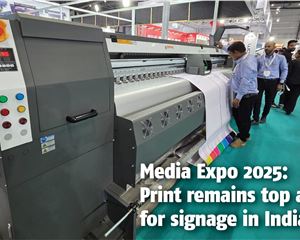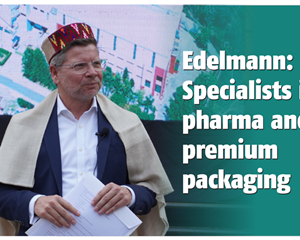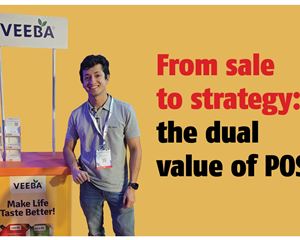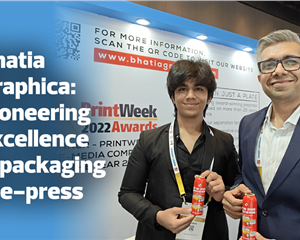428 exhibitors, 75,000-plus unique visitors, PrintPack 2017 scaled new heights.
The numerous benefits of a trade show as an effective marketing tool hardly need repeating, yet the number of serious business orders from pre-media to post-press and everything between, has been heartwarming.
This Sunday Column is about the most successful print show, which has brought print back into focus.
The IPAMA team needs to be complimented for ensuring a first-class show in spite of the doom and gloom forecasts three months ago. This augurs well for Indian print in the months to come. Many of the IPAMA members and indeed Indian manufacturers in general created an impact by delivering technology which could compete with the big boys in Asia in terms of technology and product finish.
As Sanat Shah, industry veteran, said, “Three-four industry sectors need to come together and host a unified print and packaging show in India. So, imagine a bigger and more powerful PrintPack show. This makes it convenient for trade show visitors.
Highlights at PrintPack
India is playing a major role in the global market. But in 2017, all of us want Indian printers to play a bigger role in exports. Today, India is quickly rising in the ranks of the print packaging industry and has climbed from the eighth largest market in 2011 to fifth in 2016.
 Thayer Long
Thayer Long
This was the big take-away from the presentation by Thayer Long, president, NPES. “By 2020, India will become the fourth largest market, ahead of Germany, and at this rate, shortly after the 2020, India will surpass Japan, becoming the third largest market.”
But as member of the IPAMA discussed during their GC meet, there is a high tax structure for manufacturers in India. If you compare Japan and India, you can see the difference in tax benefits for the SSI and SME industry, which is one reason why industry needs to lobby with the government of India. HV Sheth, president of the association said to me, “IPAMA is working on creating a white paper. Once PrintPack concludes, it is going to be a top priority.”
It is time we ally with CII or FICCI so that our voice is heard in the highest power centres, and we are recognised as an apex body of industrialists. This is the way for Indian manufacturers to increase capacity, to bear a higher risk, to avail economies of scale, take higher investment decisions and create more value for our customers.
In the next five years, India will be in pole position out of the 10 fastest-growing print packaging markets in Asia-Pacific. India’s revenue was USD 12.2bn in 2016. By 2020, revenues will reach USD 18.6 billion.
The flexible print packaging market in India is much larger than the folding carton market. However, the folding carton segment in India is still sizable because of exports, particularly in luxury goods and cigarettes.
But to achieve these numbers, we need to move faster.
Automation 4.0 was the buzz word
The PrintWeek India talked to two printers.
One major packaging player, said, the Capex to turnover ratio is just 1.5 times in our industry, whereas it is three times in other industries.
In addition, there is stiff competition in the market. Every day, new units emerge and shut down. So, what is the way ahead, I asked? Automation 4.0!
A book printing CEO who joined our table, said, "The price of the unit book cost has not changed much in the last 15 years. Prices have been maintained in spite of raw materials cost increasing three-fold. This is because we tend to reduce our margins."
Firms will have to automate, or we will fail to survive.
For example, two years ago, raw material has seen a 50-70%% increase. With this, working capital, debt and everything else increase by 50%. How can you sustain 50% working capital?
This is why automation is required, and this is why Automation 2.0 is the buzz word at PrintPack 2017.
Packaging at Printpack
In the past two decades, the focus has been on printing. Now with the increasing penetration of FMCG and white good products, the packaging industry was at the forefront at PrintPack
The 75,000+ visitors to the show are expecting the same quality and speed from their primary and secondary packaging solutions.
This is more than evident at stalls with lots of emphasis on post-press and end of line finishing kit. This explains the raft of products like UV and lamination devices inasmuch as rigid boxes.
Trend one: Today, customers want technology-led service experience from maintenance and technical services. This means 24/7 service support for grievances and glitches. Many exhibitors are working out a mobile and online quick service option. Some companies are using apps to improve customer experience.
Trend two: With the massive pressure on margins, most exhibitors are offering technology tweaks at PrintPack to boost automation.
Trend three: PrintPack is seeing many G2 (generation two) at the show. We spoke to one major G2 in a book printer firm who said, he is at PrintPack because digital printing is the best alternative to minimum order quantity (MOQ) of conventional printing. It is the solution to the long-drawn challenge of high inventory in the industry.
Digital print at PrintPack
The digital footprint at PrintPack created a massive buzz. From the tone of the conversations by Konica Minolta, HP, and Kodak during the first half of the NPES Business Conference, it seems to indicate that it is a matter of months when a swathe of digital devices will make a bigger impact in India.
Speaker on speaker stressed the importance of seeing digital print as a marketing tool for the entire value-added chain.
Manish Gupta of Konica Minolta
At the show, five things are coming into play.
One is pricing and the Indian market is really competitive. The second is the click charges which are lower than what the industry average has been. The third is what media can a machine print on. The fourth is, the value addition in terms of the colour management software or front-end workflow solution which can be negotiated as part of the package deal.
And finally, a trend which is unique to PrintPack. If you study, Konica Minolta machines, the company initiated the large print module in their entry level devices 6000 and 1060. The 13x39 inch size boosted the Indian graphic arts segment. In the past year or so, we see both Canon and Xerox take the journey into the long print format and implement it on their higher PPM devices. In the toner-based technology, this is providing a latent and intangible advantage.
That seems the slogan from the show: Digital prints which can guarantee more profitability at lower cost levels.
The digital print volumes have to start to add up. There is a pick up due to demonetisation and some of the security print players are printing many more cheque books and cheque leaves. But we need much more traction.
12 mantras for buyers
For all buyers at PrintPack, my team has prepared 12 mantras to be kept in the mind
- Don’t think money is idle.
- Look at alternative tax structures for your money
- Keep an eye on foreign currency
- Train your machine men. It’s their money too
- Understand your finance, don’t copy someone else’s balance sheet
- Optimise profits, reduce risks
- Plan A should be good. Plan B should be better.
(Editorial inputs for this Sunday Column are from the 24-page PrintPack Daily which was printed “live” on all five days of PrintPack 2017 by the PrintWeek India team)















 See All
See All